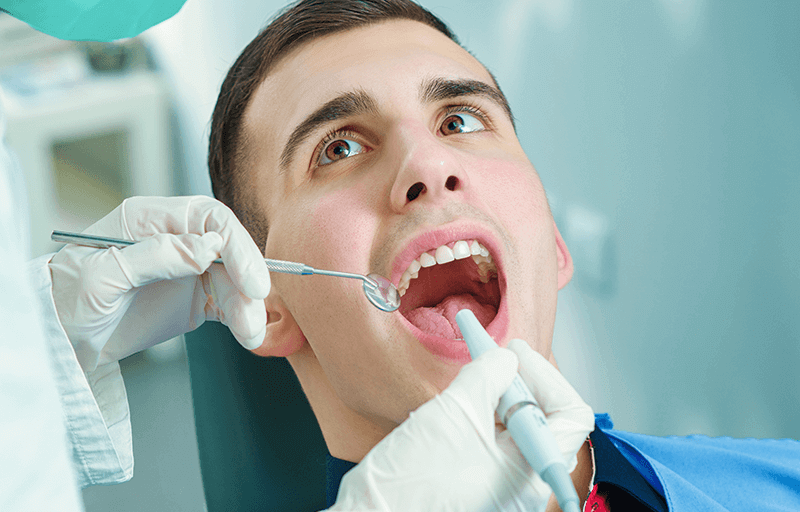Plaque is one of the frequently mentioned enemies of good dental health. Practically everybody understands the basics: plaque is bad for your teeth. But what is plaque, why is it harmful and, perhaps most importantly, how is build-up prevented?
What is Plaque?
Plaque is a soft, sticky biofilm which forms on teeth. Plaque is usually colorless when first forming, but over time can turn white, yellow or even the color of the last food or beverage consumed. Sometimes, you can feel plaque with your tongue; it’s a fuzzy, soft coating on your teeth. If you’ve ever scraped a fingernail against a tooth and seen a white residue on your nail, that’s probably plaque.
What Causes Plaque?
Plaque formation is a part of the natural ecosystem system of bacteria in our mouths, which exists to break down food particles and aid digestion. At the very least, a low level of plaque is present in your mouth at all times, and that’s generally not considered harmful. However, plaque builds up over time. If too much plaque is allowed to coat your teeth and gums, dental problems will soon follow.
When you eat and drink, tiny bits of food and beverages cling onto and between your teeth. Plaque bacteria feed on this material. But when they feed, they create an acidic waste by-product. The more plaque in your mouth, the more acid produced. Over time, acids will erode tooth enamel, which results in cavities and worse. Also, acids irritate gums, leading to gum recession, gingivitis and other forms of gum disease.
But plaque isn’t the main source of dental problems. What really causes dental damage is when plaque turns into tartar.
What is Tartar?
After about 24 to 48 hours, plaque starts to harden, mineralize and turn into a new substance called tartar. You likely won’t see tartar at first, but it’s there. After about three or four months, tartar will start to be visible on teeth, usually appearing as black, brown or yellow stains on the teeth, often around the gumline.
Tartar is permanent in the sense it can’t be removed at home. Instead, tartar can only be removed by a dental professional with a scraping, deep cleaning or other in-office procedures. Unfortunately, when tartar is left untreated, serious dental problems like gum infections and even tooth loss can eventually occur.
How Can I Prevent Plaque Build-Up?
Tartar can be difficult to remove but plaque is actually fairly easy to defeat. While you can’t (and don’t want to) completely remove all traces of plaque from your mouth, you do want to prevent plaque from building up to any significant degree.
Fortunately, plaque build-up can be prevented by focusing on four specific actions:
- Brushing
- Flossing
- Diet
- Regular Dental Check-Ups
Brushing
Brush your teeth at least twice a day, but ideally after every meal if possible. Use a soft toothbrush, which removes plaque which also protecting your gums. Brush for at least two minutes each time. Don’t forget to gently brush your tongue and the roof of your mouth, two places where bacteria likes to accumulate. Also, always remember to brush before bed. Otherwise, plaque will sit on your teeth throughout the entire night.
Flossing
Plaque builds up between teeth where brushing can’t reach – but flossing can. Flossing just once a day, at any time during the day, is very effective at preventing plaque build-up. If traditional floss is too complicated or cumbersome to use, try dental picks or an electronic water flosser.
Diet
Certain foods and beverages allow bacteria to feast and thrive, which quickly creates an acidic environment in your mouth. Generally, you’ll want to stay away from sticky, sugary foods and drinks. Avoid candy, soft drinks, sports drinks and other products packed with refined sugar.
To be fair, you don’t have to completely eliminate all sweet treats from your diet. But consume them sparingly. Also, rinse your mouth out with water immediately after eating or drinking. Then wait about 30 minutes and brush your teeth thoroughly. These two simple steps can significantly reduce the potential dental damage.
Dental Check-Ups
Daily at-home dental care is very effective at preventing plaque build-up, but it’s not enough. Regular dental visits also play an important role in keeping plaque at bay. Even if you take excellent care of your teeth, at least some tartar will likely still form. A professional cleaning from a dental professional removes any tartar you’re unable to, and helps make at-home care even more effective.
Note that six months between dental visits is only an average. Whether due to a temporary dental issue or simply genetics, some people’s mouths create tartar much quicker than others. You might need to schedule cleanings every three or four months. Your dentist will help determine a cleaning schedule appropriate for your specific needs.
Plaque buildup is serious and can lead to big problems. Fortunately, most issues can be easily prevented with a commitment to daily dental care and regular dental visits. Of course, many people are concerned about dental visit costs. One effective way to help lower your dental bills is with a dental discount plan. With a dental discount plan, you get savings of 10% to 60% at over 110,000 participating dental offices across the country. While you can save on check-ups, cleanings and all the treatments you need to keep your smile healthy and bright.


